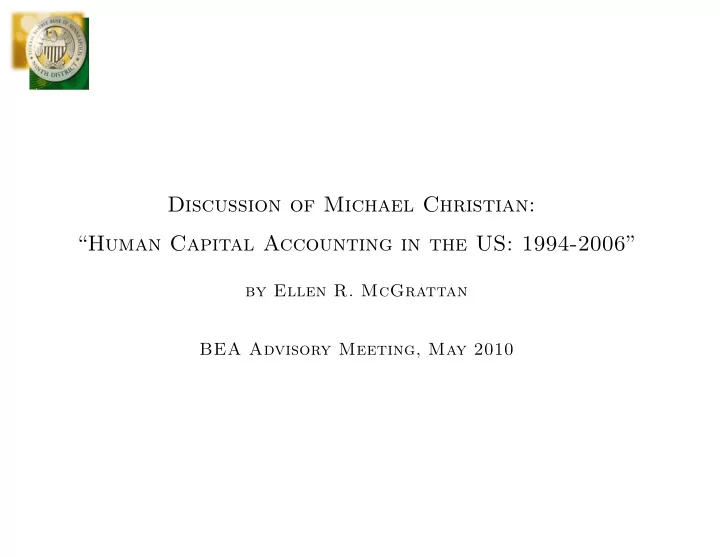

Discussion of Michael Christian: “Human Capital Accounting in the US: 1994-2006” by Ellen R. McGrattan BEA Advisory Meeting, May 2010
Christian’s Main Findings 1. US human capital stock is “gigantic” ◦ 3/4 quadrillion dollars in 2006 ◦ ≈ 55 × GDP ◦ ≈ 16 × Fixed assets + durables
Christian’s Main Findings 1. US human capital stock is “gigantic” ◦ 3/4 quadrillion dollars in 2006 ◦ ≈ 55 × GDP ◦ ≈ 16 × Fixed assets + durables Big even if nonmarket time excluded (15 × GDP)
Christian’s Main Findings 1. US human capital stock is “gigantic” ◦ 3/4 quadrillion dollars in 2006 ◦ ≈ 55 × GDP ◦ ≈ 16 × Fixed assets + durables 2. Gross investment estimates sensitive to enrollment patterns
Uses Jorgenson-Fraumeni Methodology E y,s,a,e + (1+ g ) a > 34 (1+ ρ ) π y,s,a +1 H y,s,a +1 ,e H y,s,a,e = E y,s,a,e + (1+ g ) (1+ ρ ) π y,s,a +1 ˜ a ≤ 34 H y,s,a +1 ,e ˜ H y,s,a,e = ω y,s,a,e H y,s,a +1 ,e +1 + (1 − ω y,s,a,e ) H y,s,a +1 ,e where y, s, a, e = year, sex, age, education H = human capital stock E = average yearly earnings of group π = survival probability g = growth rate of labor earnings ρ = discount rate
Human Capital >> Fixed Assets 70 Total Human Capital/GDP 60 50 Nonmarket Human Capital/GDP 40 30 Market Human Capital/GDP 20 10 (Fixed Assets+Durables)/ GDP 0 1994 1996 1998 2000 2002 2004 2006
Two Measures: Very Different Results 75 Jorgenson-Fraumeni (1992) Christian (2010) 60 Jorgenson-Fraumeni (1989) 45 30 15 Kendrick (1976) 0 1950 1955 1960 1965 1970 1975 1980 1985 1990 1995 2000 2005
Why are J-F-C Estimates so Large? • Education output treated as investment not consumption • Nonmarket time earns same after tax wage as market time • Costs of maintaining capital during lifetime not subtracted • Costs of raising children not subtracted
Why are J-F-C Estimates so Large? • Education output treated as investment not consumption • Nonmarket time earns same after tax wage as market time • Costs of maintaining capital during lifetime not subtracted • Costs of raising children not subtracted • More importantly, why does it matter?
Main Comments • Would like to see ◦ Less emphasis on the size of the stocks ◦ More emphasis on their economic importance • With the goal of better connecting theory and measurement
Consumers of the Estimates • Who are they? • Who should they be?
Consumers of the Estimates • Who are they? Satellite accountants • Who should they be?
Consumers of the Estimates • Who are they? Satellite accountants • Who should they be? ◦ Labor economists studying education policy ◦ Development economists studying income differences ◦ Financial economists studying asset pricing ◦ Macroeconomists studying business cycles
Economic Importance of Estimates • Issues in labor ◦ What are implications for returns to education? ◦ How are the implied returns different from Mincer’s? • Issues in development ◦ What are implications for education policies of poor? ◦ And for true income & wealth differences?
Economic Importance of Estimates • Issues in finance ◦ What are implications for asset prices? ◦ Do they help resolve any outstanding puzzles? • Issues in macro ◦ What are implications for business cycles? ◦ Do they shed light on the large labor wedge?
Recommendations for Future • Focus on specific economic questions • Specify economic environment fully ◦ What are the production technologies? ◦ Who are the owners of productive factors? ◦ What is consumption, investment? ◦ What transactions occur? • Construct model accounts using current BEA methodology
Recommend
More recommend